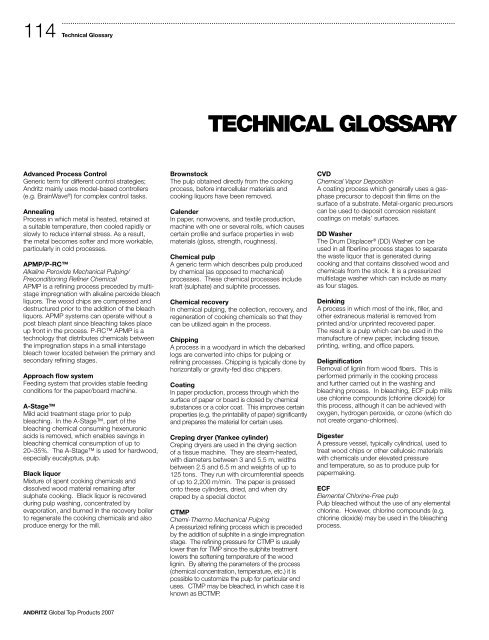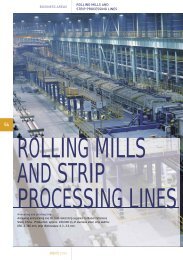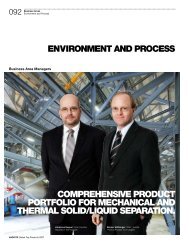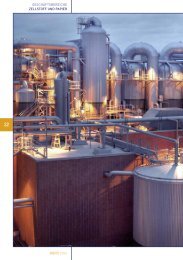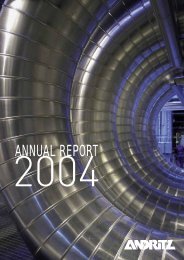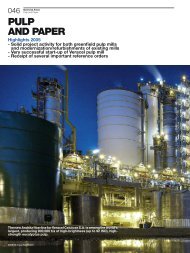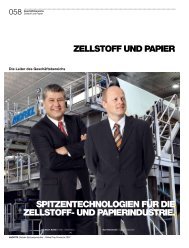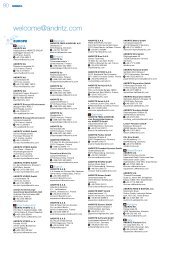Download as pdf - andritz business areas
Download as pdf - andritz business areas
Download as pdf - andritz business areas
- No tags were found...
You also want an ePaper? Increase the reach of your titles
YUMPU automatically turns print PDFs into web optimized ePapers that Google loves.
114<br />
Technical Glossary<br />
TECHNICAL GLOSSARY<br />
Advanced Process Control<br />
Generic term for different control strategies;<br />
Andritz mainly uses model-b<strong>as</strong>ed controllers<br />
(e.g. BrainWave ® ) for complex control t<strong>as</strong>ks.<br />
Annealing<br />
Process in which metal is heated, retained at<br />
a suitable temperature, then cooled rapidly or<br />
slowly to reduce internal stress. As a result,<br />
the metal becomes softer and more workable,<br />
particularly in cold processes.<br />
APMP/P-RC<br />
Alkaline Peroxide Mechanical Pulping/<br />
Preconditioning Refiner Chemical<br />
APMP is a refining process preceded by multistage<br />
impregnation with alkaline peroxide bleach<br />
liquors. The wood chips are compressed and<br />
destructured prior to the addition of the bleach<br />
liquors. APMP systems can operate without a<br />
post bleach plant since bleaching takes place<br />
up front in the process. P-RC APMP is a<br />
technology that distributes chemicals between<br />
the impregnation steps in a small interstage<br />
bleach tower located between the primary and<br />
secondary refining stages.<br />
Approach flow system<br />
Feeding system that provides stable feeding<br />
conditions for the paper/board machine.<br />
A-Stage<br />
Mild acid treatment stage prior to pulp<br />
bleaching. In the A-Stage, part of the<br />
bleaching chemical consuming hexenuronic<br />
acids is removed, which enables savings in<br />
bleaching chemical consumption of up to<br />
20–35%. The A-Stage is used for hardwood,<br />
especially eucalyptus, pulp.<br />
Black liquor<br />
Mixture of spent cooking chemicals and<br />
dissolved wood material remaining after<br />
sulphate cooking. Black liquor is recovered<br />
during pulp w<strong>as</strong>hing, concentrated by<br />
evaporation, and burned in the recovery boiler<br />
to regenerate the cooking chemicals and also<br />
produce energy for the mill.<br />
Brownstock<br />
The pulp obtained directly from the cooking<br />
process, before intercellular materials and<br />
cooking liquors have been removed.<br />
Calender<br />
In paper, nonwovens, and textile production,<br />
machine with one or several rolls, which causes<br />
certain profile and surface properties in web<br />
materials (gloss, strength, roughness).<br />
Chemical pulp<br />
A generic term which describes pulp produced<br />
by chemical (<strong>as</strong> opposed to mechanical)<br />
processes. These chemical processes include<br />
kraft (sulphate) and sulphite processes.<br />
Chemical recovery<br />
In chemical pulping, the collection, recovery, and<br />
regeneration of cooking chemicals so that they<br />
can be utilized again in the process.<br />
Chipping<br />
A process in a woodyard in which the debarked<br />
logs are converted into chips for pulping or<br />
refining processes. Chipping is typically done by<br />
horizontally or gravity-fed disc chippers.<br />
Coating<br />
In paper production, process through which the<br />
surface of paper or board is closed by chemical<br />
substances or a color coat. This improves certain<br />
properties (e.g. the printability of paper) significantly<br />
and prepares the material for certain uses.<br />
Creping dryer (Yankee cylinder)<br />
Creping dryers are used in the drying section<br />
of a tissue machine. They are steam-heated,<br />
with diameters between 3 and 5.5 m, widths<br />
between 2.5 and 6.5 m and weights of up to<br />
125 tons. They run with circumferential speeds<br />
of up to 2,200 m/min. The paper is pressed<br />
onto these cylinders, dried, and when dry<br />
creped by a special doctor.<br />
CTMP<br />
Chemi-Thermo Mechanical Pulping<br />
A pressurized refining process which is preceded<br />
by the addition of sulphite in a single impregnation<br />
stage. The refining pressure for CTMP is usually<br />
lower than for TMP since the sulphite treatment<br />
lowers the softening temperature of the wood<br />
lignin. By altering the parameters of the process<br />
(chemical concentration, temperature, etc.) it is<br />
possible to customize the pulp for particular end<br />
uses. CTMP may be bleached, in which c<strong>as</strong>e it is<br />
known <strong>as</strong> BCTMP.<br />
CVD<br />
Chemical Vapor Deposition<br />
A coating process which generally uses a g<strong>as</strong>ph<strong>as</strong>e<br />
precursor to deposit thin films on the<br />
surface of a substrate. Metal-organic precursors<br />
can be used to deposit corrosion resistant<br />
coatings on metals’ surfaces.<br />
DD W<strong>as</strong>her<br />
The Drum Displacer ® (DD) W<strong>as</strong>her can be<br />
used in all fiberline process stages to separate<br />
the w<strong>as</strong>te liquor that is generated during<br />
cooking and that contains dissolved wood and<br />
chemicals from the stock. It is a pressurized<br />
multistage w<strong>as</strong>her which can include <strong>as</strong> many<br />
<strong>as</strong> four stages.<br />
Deinking<br />
A process in which most of the ink, filler, and<br />
other extraneous material is removed from<br />
printed and/or unprinted recovered paper.<br />
The result is a pulp which can be used in the<br />
manufacture of new paper, including tissue,<br />
printing, writing, and office papers.<br />
Delignification<br />
Removal of lignin from wood fibers. This is<br />
performed primarily in the cooking process<br />
and further carried out in the w<strong>as</strong>hing and<br />
bleaching process. In bleaching, ECF pulp mills<br />
use chlorine compounds (chlorine dioxide) for<br />
this process, although it can be achieved with<br />
oxygen, hydrogen peroxide, or ozone (which do<br />
not create organo-chlorines).<br />
Digester<br />
A pressure vessel, typically cylindrical, used to<br />
treat wood chips or other cellulosic materials<br />
with chemicals under elevated pressure<br />
and temperature, so <strong>as</strong> to produce pulp for<br />
papermaking.<br />
ECF<br />
Elemental Chlorine-Free pulp<br />
Pulp bleached without the use of any elemental<br />
chlorine. However, chlorine compounds (e.g.<br />
chlorine dioxide) may be used in the bleaching<br />
process.<br />
ANDRITZ Global Top Products 2007


